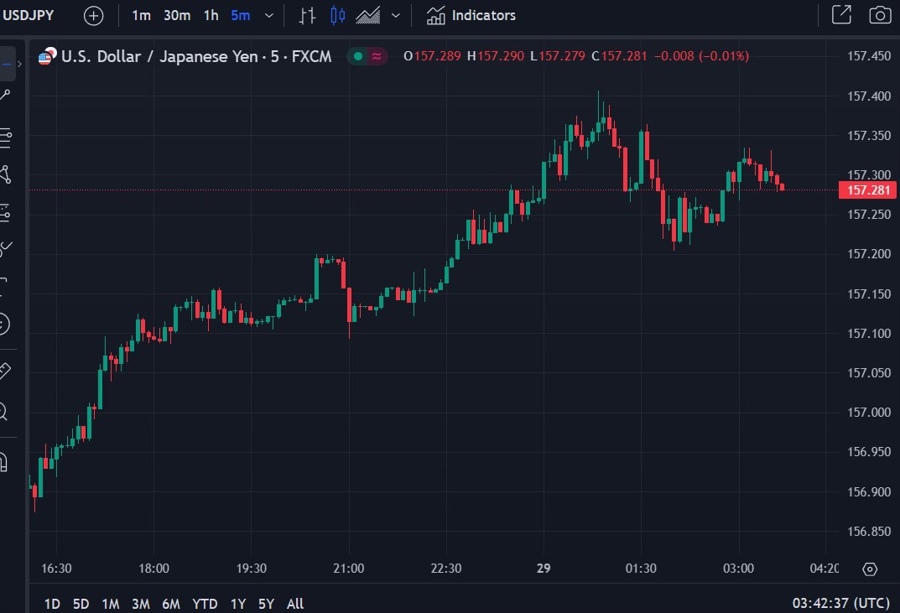- Federal Reserve speakers Wednesday include Williams and Bostic - Beige book also published
- More from IMF on China: Fiscal policy needs to reorient further to domestic consumption
- IMF Deputy Managing Director sees scope for more policy to address China property sector
- The IMF has upgraded China's economic growth target to 5%, from 4.6%
- AUD popped after the higher than expected monthly inflation data
- BOJ's Adachi says if excessive yen falls impact inflation, policy response becomes option
- Australian data: Q1 Construction work completed -2.9% q/q vs. +0.5% expected
- Australian April CPI 3.6% y/y (expected 3.4%)
- PBOC sets USD/ CNY central rate at 7.1106 (vs. estimate at 7.2528)
- New Zealand May business confidence 11.2% (prior 14.9%)
- Australian data: Westpac Leading Index for April -0.03% m/m (prior -0.05%)
- US military says a Greek-owned and operated vessel reported being struck by 3 missiles
- Bitcoin and Ethereum (ETNs) begin trading on the London Stock Exchange
- Goldman Sachs raise their global oil demand forecast, see significant demand acceleration
- Artificial Intelligence has cracked the stock market
- UBS on forthcoming ECB rate cuts - due to narrative
- Kashkari on (higher) Fed rates: Unlikely but "I don’t want to take anything off the table"
- Forexlive Americas FX news wrap 28 May: USD rebounds helped by rising yields &confidence
- S&P 500 could drop back under 5000 if there are no US Federal Reserve rate cuts this year
- NASDAQ new record driven by Nvidia
- Trade ideas thread - Wednesday, 29 May, insightful charts, technical analysis, ideas
After its rise during Europe and US times on Tuesday the USD added a few more points during the Asia session.
EUR, GBP, NZD, CAD all traded lower while USD/CHF stalled. AUD/USD managed a pop higher as worsening inflation data prompted thoughts of an RBA pushing rate cuts further into the distance (more to come on the data and AUD).
Most focus, of course, was on JPY. USD/JPY traded in a quiet manner, heading up to 157.40 before stabilising not too far from there. We haven’t had any verbal intervention attempts out of Japan today, but we did have a speech from Bank of Japan board member Seiji Adachi. Adachi covered a lot of ground on policy matters in his speech, but the headlines tended to settle on conveying his message that the Bank of Japan may raise interest rates if sharp falls in the yen boost inflation, or the public's perception of future prices move more than expected. This helped USD/JPY dribble back from its highs a little.
From China today we had news that two major cities, Shenzhen and Guangzhou, activated policies to support the property sector, such as cutting minimum down payment ratios for home buyers and such. Supportive measures in lesser-tier cities in China have not been met with much fanfare, the stimulus is now moving into top-tier cities.
From the PBOC was a setting of the yuan reference rate at its weakest (for the CNY) since the 23rd of January this year, and also a big injection (net 248bn yuan) in 7 day reverse repos, the largest single day injection since April 30.
The IMF weighed in on China, encouraging more policy support and raising China's 2024 GDP growth forecast to 5.0% from 4.6% (and 2025 to 4.5% from 4.1%), citing strong Q1 economic growth data and recent policy measures.
From Australia we had a small increase in the monthly CPI, both headline and core. The stalling of progress towards lower inflation is strongly suggestive that the RBA will hold its cash rate where it is for longer. While today’s monthly CPI is not ‘official’ quarterly data, its not going to be ignored by the Bank either. The data is not going to be enough to push the RBA to hike rates, but if the lack of progress persists and is reflected in the quarterly data (due July 31) then another hike cannot be ruled out. This sounds a little alarmist, but at the beginning of July Australians get generous tax cuts. If these are spent rather than saved it could well fuel further inflation.




